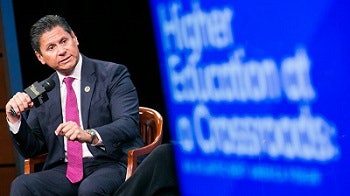San Diego Mesa College, Sacramento City College and Butte College are the latest community colleges to launch a student support program geared toward foster youth in higher education.
The expansion of NextUp – a program housed under the Extended Opportunity Programs and Services (EOPS) – to 15 additional California community colleges will help new host institutions promote foster youth’s academic success in higher education. The program will provide students with personalized support services, including educational planning, emergency housing assistance, food assistance, financial literacy and counseling and career guidance.
 California Community Colleges Chancellor Eloy Ortiz Oakley
California Community Colleges Chancellor Eloy Ortiz OakleyFormerly known as the Cooperating Agencies Foster Youth Educational Support (CAFYES) program, NextUp will now be available to students attending American River College, Cosumnes River College, Folsom Lake College, Bakersfield College, Cerro Coso Community college, Porterville College, Chaffey Community College, Moreno Valley College, Norco College, Riverside City College, San Diego City College and San Diego Miramar College.
To be eligible for participation in NextUp, students must be taking nine units at a college with the program, must be under the age of 26 and must have been in foster care on or after their 16th birthday.
“Foster youth have one of the lowest college graduation rates and providing the basic services such as personal counseling, educational plan, case management services, follow-up services and a variety of educational needs were not being met,” said Sade Burrell, an assistant professor and EOPS special populations counselor at San Diego Mesa College.
Burrell played an integral role in securing funding for NextUp programs in the San Diego Community College District. With more resources, she said the program can fill in the gaps in services previously offered to foster youth in the district’s colleges that also include San Diego City College and San Diego Miramar College.
Program leaders now have a goal to support nearly 90 to 100 eligible students.
“Services such as transportation, textbook support, personal development and financial workshops, technology support, child care assistance (for those with children) and activities such as campus tours will allow us to properly serve foster youth at Mesa College,” Burrell said.
A former foster youth herself, Burrell added insight on the challenges support staff face when aiding students, including not having the adequate staff to serve the population.
“Serving foster youth requires a lot of follow-up and following through on the students’ end and on the end of the faculty member serving the students,” she said. With NextUp, she added, “we plan to hire more trauma-informed staff members to support foster youth by assisting them with personal counseling and case management services.”
Established by state Senate Bill 1023 in 2014, NextUp is administered by the Student Services and Special Programs Division of the California Community College Chancellor’s Office. Sixteen community college districts currently host the program.
 Lydell Willis
Lydell Willis“Students in foster care often face a more challenging path to higher education than many of their peers,” California Community Colleges Chancellor Eloy Ortiz Oakley said. “Expanding this important program to more colleges will give more foster youth the tools they need to succeed in college and help them accomplish their higher educational goals.”
At the College of Alameda, NextUp program manager Lydell Willis is responsible for connecting students with community-based resources that assist them with housing, medical care and other supplemental support services they may need to stay engaged and successful in school.
NextUp serves approximately 38 students at the college and more than 120 students in the overall Peralta Community College District. Students participating in the program – now in its third year – receive extra grants to help them buy books or gas cards, for example, and they also have their own academic counselor who specializes in working with foster youth.
Willis shared that the challenges foster youth face are similar to the challenges affecting first-generation students: having to navigate the education system, understanding how financial aid works and accessing supportive resources.
Specific foster youth challenges stem from students potentially having multiple K-12 school placements in their lifetime, Willis added, noting that every time a child moves or changes schools, “it’s like losing three months of education.”
Another primary challenge for foster youth is securing housing while enrolled in college.
“Not many of our students – if they didn’t have any kind of housing stability – can pay, let’s say, $1,800 a month for a one-bedroom [apartment] and go to school part-time,” Willis said.
The connection that students have with those dedicated to supporting them also makes a difference, Willis added. Because of this, he has an “open-door” policy for students.
The College of Alameda’s NextUp program will graduate its first cohort of students on May 25. Three former foster students from the program will graduate and go on to Clark Atlanta University, California State University, East Bay and San Francisco State University, Willis said.
The moment speaks to observations Willis has made in his 12 years working with foster youth.
“Over my years, foster youth specifically have been some of the most resilient students I’ve met,” he said. “As far as life resilience, finding their services and advocating for themselves, I haven’t met as many students as determined to do that.”
Bolstering students’ academic resilience is at the forefront of Willis’ – and other NextUp leaders’ – work, as foster youth supporters consider ways to help students learn useful study habits among other tools they can implement to succeed academically.
“Once they get back that first ‘A’ or ‘B’ in the class, and they realize, ‘You know what, I can do this college thing,’ … usually after that, they just start to blossom,” Willis said. “It’s really exciting to see where they go after that.”
Tiffany Pennamon can be reached at [email protected]. You can follow her on Twitter @tiffanypennamon.


















